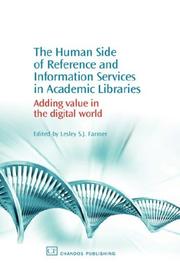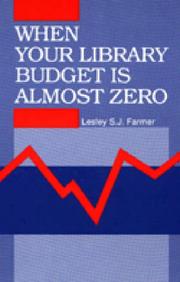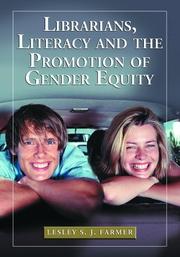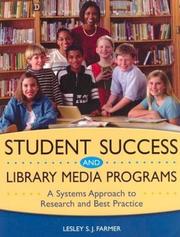| Listing 1 - 10 of 18 | << page >> |
Sort by
|

ISBN: 9781843342571 9781843342588 184334257X 1843342588 9781780631004 1780631006 Year: 2007 Publisher: Oxford, England : Chandos Publishing,
Abstract | Keywords | Export | Availability | Bookmark
 Loading...
Loading...Choose an application
- Reference Manager
- EndNote
- RefWorks (Direct export to RefWorks)
This book examines the questions: how academic libraries provide value-added reference and information services in the digital age. It provides best practices from a global perspective. The book starts by looking at the information needs and info-seeking behaviours of university students and faculty. Then it examines the use cycle: consumer, instruction, and producer. It examines the resource cycle: collection development, instructor, maintenance. What are the essential elements of reference: orientation, instruction, collaborative planning, products?Focuses on information need
Library management --- Information retrieval --- Academic libraries --- Internet in library reference services. --- Bibliothèques universitaires --- Internet dans les services de référence (Bibliothèques) --- Reference services. --- Services de référence --- 025.5 --- 025.5 Inlichtingenwerk. Reference services --- Inlichtingenwerk. Reference services --- Internet in reference services (Libraries) --- Reference services (Libraries)

ISBN: 0872879909 Year: 1993 Publisher: Englewood, CO : Libraries Unlimited,
Abstract | Keywords | Export | Availability | Bookmark
 Loading...
Loading...Choose an application
- Reference Manager
- EndNote
- RefWorks (Direct export to RefWorks)
025.11 --- Library finance --- -Libraries --- Bibliotheekbeheer: financies, budgettering, kostencalculatie --- Finance --- -Bibliotheekbeheer: financies, budgettering, kostencalculatie --- 025.11 Bibliotheekbeheer: financies, budgettering, kostencalculatie --- -025.11 Bibliotheekbeheer: financies, budgettering, kostencalculatie --- Libraries --- Bibliotheques --- Bibliotheques americaines --- Administration
Book
ISBN: 0838915159 9780838915158 9780838915165 0838915167 9780838914946 0838914942 9780838915172 Year: 2017 Publisher: Chicago: American Library Association,
Abstract | Keywords | Export | Availability | Bookmark
 Loading...
Loading...Choose an application
- Reference Manager
- EndNote
- RefWorks (Direct export to RefWorks)
School librarians must not only manage the library, but also serve as educational leaders. Farmer shows how school library programs must be planned in light of standards and school community needs. She compares and differentiates between management and leadership, and provides guidelines to help you transition from competent manager to inspiring leader.
School libraries --- Administration. --- School librarians --- Vocational guidance. --- Librarians --- School employees
Book
ISBN: 1442239824 1442239808 1442239816 9781442239821 9781442239807 9781442239814 Year: 2016 Publisher: Lanham : Rowman & Littlefield,
Abstract | Keywords | Export | Availability | Bookmark
 Loading...
Loading...Choose an application
- Reference Manager
- EndNote
- RefWorks (Direct export to RefWorks)
Information and Digital Literacies: A Curricular Guide for Middle and High School Librarians is a practical guide to help school librarians design and deliver effective instruction that addresses the knowledge, skills and dispositions of information and digital literacies. The ready-to-implement curricular guide features instructional design strategies, model middle and high school curriculum, including a scope-and-sequence, stand-alone courses, units of instruction, and sample learning activities, and ties to new AASL and ACRL information literacy standards, ISTE technology standards, 21st Ce
Information literacy --- Computer literacy --- School librarian participation in curriculum planning --- School librarians --- School libraries --- Study and teaching (Middle) --- Study and teaching (Secondary) --- Effect of technological innovations on --- Information technology --- Literacy, Information --- Information science --- Public school libraries --- Libraries --- Instructional materials centers --- Libraries and schools --- Librarians --- School employees --- Curriculum planning --- Digital literacy --- Literacy, Computer --- Technological literacy

ISBN: 0786423447 Year: 2005 Publisher: Jefferson McFarland & Company
Abstract | Keywords | Export | Availability | Bookmark
 Loading...
Loading...Choose an application
- Reference Manager
- EndNote
- RefWorks (Direct export to RefWorks)
We leven in een informatiemaatschappij, deze vaststelling is een beetje zoals een open deur intrappen. De media produceren een constante stroom van auditieve, visuele en digitale informatie. Hieruit de juiste en relevante informatie halen is een vaardigheid op zich. Geletterdheid krijgt een heel nieuwe, ruimere en complexere invulling. Een hele uitdaging om jongeren hiermee vertrouwd te maken. In dit boek wordt de rol van dé informatiespecialist bij uitstek de school bibliothecar(is)esse belicht. Belangrijk is ook om bij het aanleren van de kennis en vaardigheden rekening te houden met een gelijke behandeling van meisjes en jongens. Aandacht voor de verschillende leerstijlen van jongens en meisjes is hierbij een must.
Documentation and information --- Developmental psychology --- Sociology of culture --- Sociology of the family. Sociology of sexuality --- Social policy --- Educational psychology --- Teaching --- Computer. Automation --- Equal opportunities --- Gender --- Computer science --- Boys --- Academic performance --- Reading habits --- Girls --- Education --- Libraries --- Book --- United States of America
Book
Year: 2008 Publisher: New York Teachers College Press
Abstract | Keywords | Export | Availability | Bookmark
 Loading...
Loading...Choose an application
- Reference Manager
- EndNote
- RefWorks (Direct export to RefWorks)
Het beeld van tieners die veel en gemakkelijk technologie gebruiken is een stereotiep beeld dat niet helemaal klopt. De realiteit levert een meer genuanceerd beeld op. Volwassenen schatten de daadwerkelijke technische kennis van jongeren veeleer te hoog in, zoals uit de cijfers blijkt. Zo is de telefoon de meest gebruikte technologie onder jongeren. Bijna de helft van de jongeren gebruikt zelden of nooit het internet. Het zijn vooral de meisjes die sterk achterblijven als gebruiker van de nieuwste technologieën. Op de lagere school gebruiken nog evenveel jongens als meisjes de computer. In het secundair onderwijs verandert die houding t.o.v. computergebruik, dan nemen jongens het voortouw in de technologielessen. Ook qua studiekeuze nemen meisjes niet zo vlug technologie of wiskunde in hun lessenpakket op. In dit boek zoekt de auteur een verklaring voor deze verandering in attitude van de meisjes.
Developmental psychology --- Community organization --- Educational psychology --- Secondary education --- Computer. Automation --- Computer science --- Academic performance --- Girls --- Participation --- Attitudes --- Book

ISBN: 9781843342571 9781843342588 184334257X 1843342588 9781780631004 1780631006 Year: 2007 Publisher: Oxford Chandos
Abstract | Keywords | Export | Availability | Bookmark
 Loading...
Loading...Choose an application
- Reference Manager
- EndNote
- RefWorks (Direct export to RefWorks)
This book examines the questions: how academic libraries provide value-added reference and information services in the digital age. It provides best practices from a global perspective. The book starts by looking at the information needs and info-seeking behaviours of university students and faculty.
Book
ISBN: 9780367416805 9780367406042 Year: 2020 Publisher: London ; New York : Routledge,
Abstract | Keywords | Export | Availability | Bookmark
 Loading...
Loading...Choose an application
- Reference Manager
- EndNote
- RefWorks (Direct export to RefWorks)
"Fake News in Context defines fake news and sets it within a historical and international context. Helping readers to become more skilled at detecting misinformation, the book also demonstrates how such knowledge can be leveraged to facilitate more effective engagement in civic education. Distinguishing between fake news and other forms of misinformation, the book explains the complete communication cycle of fake news: how and why it is created, disseminated, and accessed. The book then explains the physical and psychological reasons why people believe fake news. Providing generic methods for identifying fake news, Farmer also explains the use of fact-checking tools and automated algorithms. The book then details how various literacies, including news, media, visual, information, digital and data, offer unique concepts and skills that can help interpret fake news. Arguing that individuals and groups can respond and counter fake news, which leads to civic engagement and digital citizenship, the book concludes by providing strategies for instruction and tips for collaborating with librarians. Including a range of international examples, Fake News in Context will be of interest to teaching faculty, and students of library and information science, communication studies, media studies, politics and journalism. Librarians and information professionals will also find a valuable resource in this book"--

ISBN: 1591580587 Year: 2003 Publisher: Westport (Conn.) Libraries unlimited
Abstract | Keywords | Export | Availability | Bookmark
 Loading...
Loading...Choose an application
- Reference Manager
- EndNote
- RefWorks (Direct export to RefWorks)
Academic achievement --- Media programs (Education) --- School libraries
Book
ISBN: 9781555707361 Year: 2011 Publisher: New York Neal-Schuman
Abstract | Keywords | Export | Availability | Bookmark
 Loading...
Loading...Choose an application
- Reference Manager
- EndNote
- RefWorks (Direct export to RefWorks)
Curriculum planning --- Information literacy --- Instructional systems --- Libraries and education --- Technological literacy --- Study and teaching --- Design
| Listing 1 - 10 of 18 | << page >> |
Sort by
|

 Search
Search Feedback
Feedback About UniCat
About UniCat  Help
Help News
News